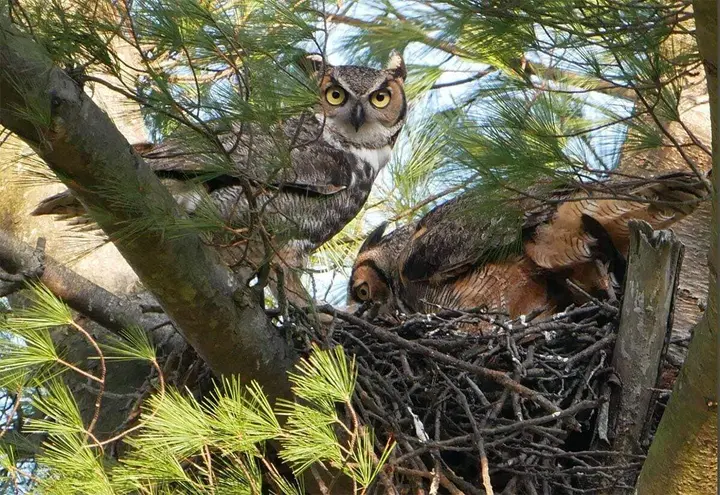Great horned owls raising owlets near main Northport road

A great horned owl couple raising at least two owlets in a highly visible nest in Northport has garnered much attention lately, with cars lining the oftentimes busy road to get a peek of the neighborhood’s newest inhabitants. To protect the owl family from too many spectators, the Northport Journal will not disclose where the nest is, though many familiar with the area will know its location from the handful of people and photographers gazing up at the birds during the day.
According to the New York State Department of Environmental Conservation (NYSDEC), great horned owls are quite common statewide and can be found in a wide variety of habitats including open and secondary growth forests, agricultural and open fields, and urban and suburban areas. The NYSDEC lists Cold Spring Harbor State Park as one of its top five locations to see a great horned owl in New York State, and Sweetbriar Nature Center in Smithtown is known to rescue, rehabilitate and release many great horned owls locally.
Sweetbriar Wildlife Care Coordinator Isabel Fernandez said the center has already renested two great horned owlets this year, including one in an East Northport backyard. Currently, four great horned owls – unable to safely return to their natural habitats – are permanent residents at the nature center.
Great horned owls are one of the earliest nesting birds in North America, beginning their courtship in November or December, said Isabel. They generally don’t build their own nests, preferring instead to build upon an already established one, perhaps a hawk or squirrel nest, she said.
Eggs will usually have hatched by the end of January – give or take, said Isabel – and the owlets will stay in the nest for four weeks, or until they get too big to be in there any longer.
When the young are about six weeks old, their feet are as big as they are going to get and incredibly strong. This is known as the “brancher stage” of a young great-horned owl’s life, reads a post on Sweetbriar’s Facebook page. If a heavy storm or wind knocks the nest over, they can use those strong toes to grip the surrounding branches. If they get blown out of a tree, their feet are strong enough to climb into low bushes.
“They’re not great flyers, so they’ll hang out on the branches of the tree, or some shrubs, somewhere they can get a little bit of cover,” Isabel explained. The owl parents will continue to feed them, and even when the owlets begin to hunt on their own, they’ll stay with their parents for a couple of months, becoming independent and seeking out their own territory around September.
The owls are most active at night, but may hunt during the day; Northport resident Francisco Rodriguez recently spotted – and photographed – the father owl securing a snake dinner before bringing it back to the nest, where mom fed it to the babies. Francisco says he first glimpsed an owlet in the Northport nest about ten days ago, though it’s likely the babies have been there for weeks.
“As a hunter, there are no other birds as proficient or as determined as the great horned owl,” reads another Sweetbriar post. “The primary purpose of the owl’s talons is to capture prey,” the post continues. “The great horned owl doesn’t launch its secret weapon straightaway; it extends its powerful talons when it is inches away from the prey…. When clenched, a great horned owl’s strong talons require a force of 28 pounds to open.” The talon itself is able to exert a pressure of 500 pounds per square inch – that’s stronger than a bald eagle’s and comparable to that of a golden eagle, or to that of a German shepherd's bite.
“Here on Long Island, the great horned owl is our apex predator,” said Isabel; a healthy adult has no natural predators. Both adult and younger owls are generally not aggressive, and the adult owls are more afraid of humans than anything else.
“It’s always safe to keep a distance and not harass [the owls] because we don’t want to stress them out,” advised Isabel. Taking photos or observing great horned owls from a distance are fine, she said, but “once a bird is nervous and flying off the nest, or away from the young, or not able to feed the young, then that’s a problem.”
Should you come into contact with an owlet in distress, contact Sweetbriar Nature Center at 631-979-6344 between 9:30am and 4:30pm. Sweetbriar also has on its website a page with instructions on what to do when finding an animal. Licensed wildlife rehabbers can also be found on the DEC's rehabber list.

Daddy owl after securing a snake dinner for his owlets. Photograph by Northport resident Francisco Rodriguez, @hipogrito.

The mother owl rests in the nest with her two owlets. Photograph by Northport resident Francisco Rodriguez, @hipogrito.
Don’t miss a story
Get the latest news delivered to your inbox.








